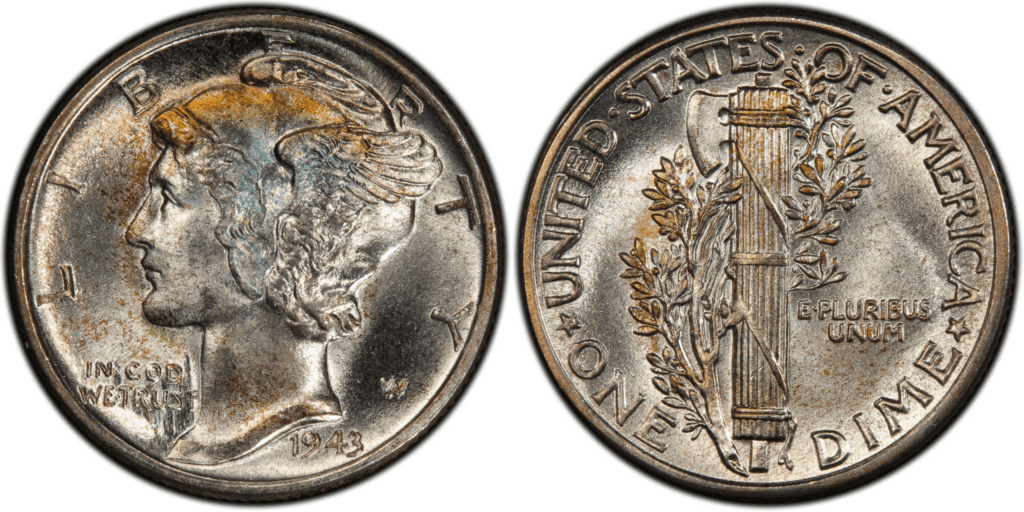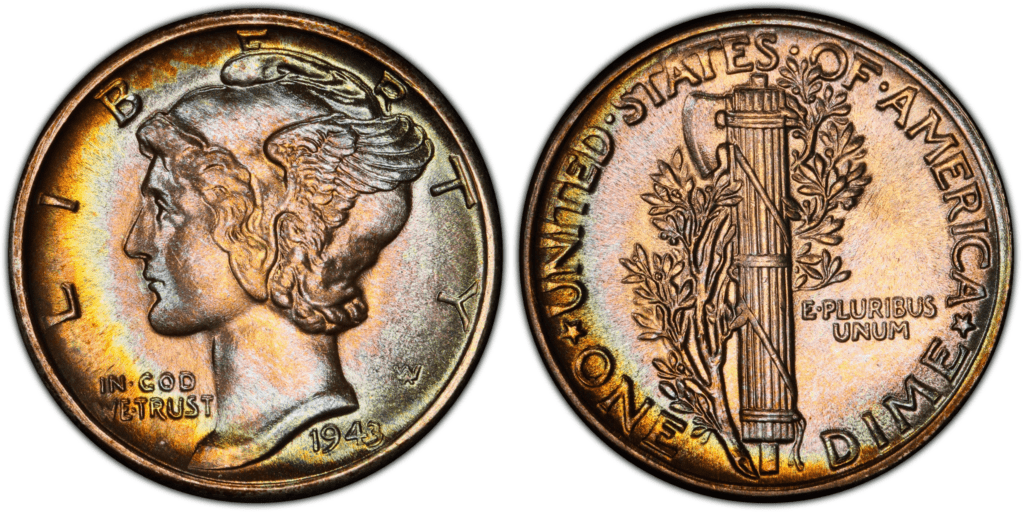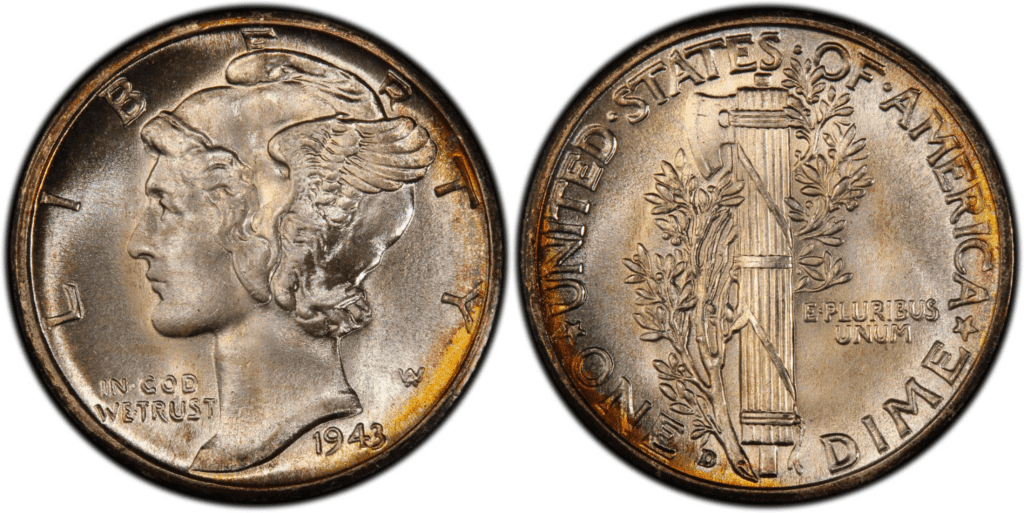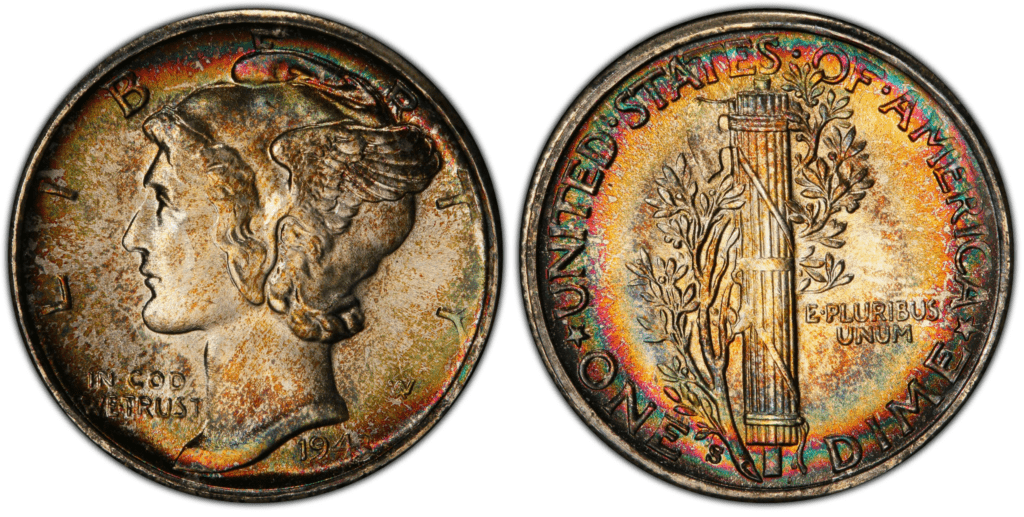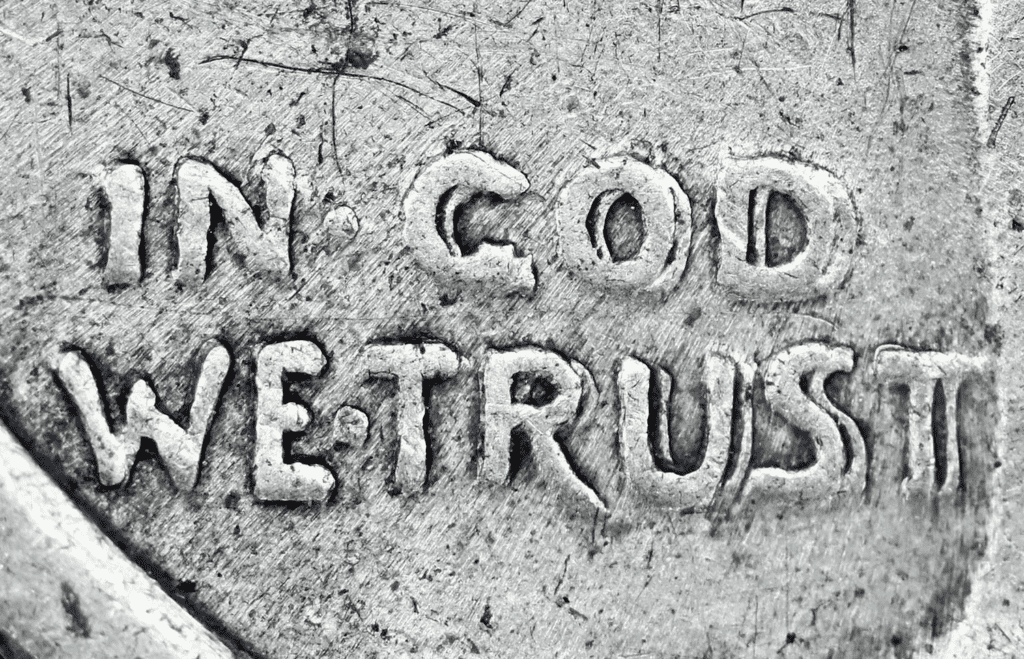Despite its modest beginnings, the United States Mint has grown to become one of the world’s biggest and most well-known minting operations. The mint has created numerous coins over the course of its illustrious history, many of which are today very well-liked among collectors. These coins come in various sizes and numbers, but as long as the US Mint name is on them, they will be regarded as collectibles.
The Mercury Dime is just one of several coins that collectors now prize, but it is undoubtedly one of the US Mint’s best-known creations. These 10-cent coins, which were produced in the early part of the 20th century, were essential to the life of regular Americans.
What Is the 1943 Mercury Dime Made Of?
Despite its small size, the “Mercury” dime might be the most attractive coin the US Mint has ever made. It is very amazing that a coin this little could have such a complex and beautiful design.
Adolph A. Weinman created the Mercury dime, also called the Winged Liberty Head dime, which replaced the Barber (or Liberty Head) dime created by Charles E. Barber and introduced in 1892. The Mercury dime type was circulated from 1916 to 1945; none were produced in 1932 or 1933. Most of the issues from 1916 to 1931 proved far scarcer than those from 1934.
The Mercury dime pieces minted between 1941 and 1945, undoubtedly the most prolific period for this series in terms of overall mintages and availability of samples in the Gem Mint State grades will typically be the least expensive type representatives from the Mercury dime.
Many collectors prefer samples from the earliest years of the Mercury dime period, when many important key and semi-key issues, such as the 1916-D, 1921, and 1921-D, were published, even though the least expensive issues are from the series’ last years. Other dates, such as several branch-mint issues from the teens and ’20s, are used as conditional keys and semi-keys.
Image Source: PCGS
This coin has a diameter of 17.90 mm and weighs 2.50 grams. It is composed of 90% Silver and 10% Copper.
Winged Liberty, or Mercury (the Roman god of commerce), is pictured on the obverse facing left, with the word LIBERTY written around the outside. The date is positioned immediately below the bust at around 5 o’clock. The words IN GOD WE TRUST are displayed left of the neck. To the right of Mercury’s neck, the designer’s initials, “AW.”
On the reverse side, an ax head and olive branches are positioned vertically in the center of a huge torch. You can read the inscription E PLURIBUS UNUM on the right side of the torch. Around the edge are the words UNITED STATES OF AMERICA on top and ONE DIME at the bottom. If there is a mint mark, it can be seen around the torch’s left bottom rim.
1943 Mercury Dime Varieties
There were four official varieties of the 1943 Mercury dime. The varieties look the same, but the main difference is their mint mark, which indicates where the coin was struck.
Here is a summary of the Winged Liberty Head dimes minted in 1943:
| Series | Location Minted | Quantity Minted |
| 1943 | Philadelphia | 191,710,000 |
| 1943 D | Denver | 71,949,000 |
| 1943 S | San Francisco | 60,400,000 |
| Total | 324,059,000 |
With that said, here’s a deeper look at the different 1943 Mercury dime varieties:
1943 P Mercury Dime
Edge: Reeded
Mint Mark: none
Place of minting: Philadelphia
Year of minting: 1943
Face Value: $0.10 (ten cents)
Price: $2.21 to $4.69 (Circulated condition)
Quantity produced: 191,710,000
Designer: Adolph Alexander Weinman
Composition: 90% Silver and 10% Copper
Mass: 2.5 grams
Diameter: 90 millimeters
Image Source: PCGS
The 1943 Philadelphia Mercury dimes are extremely common over most of the grading spectrum, from low-end circulated grades through at least MS66, with higher-grading coins, with the exception of MS68 specimens, being scarce but not particularly rare.
The Philadelphia Mint produced 191,710,000 Winged Liberty Head (Mercury) dimes. Thus, with a plentiful supply of gems, this high-mintage issue is quite common in Mint State.
The majority of coins lack Full Bands. However, this fact is concealed by the increased submission of FB coins for grading. Any collector can find enough nice pieces to satisfy them, though.
Because the Philadelphia Mint produced almost 200 million dimes that year, many dies were needed. This raises the intriguing question of why only one DDR has been discovered when multiple doubled-die versions are known.
A 1943 Mercury dime in circulated condition, according to the NGC Price Guide, is valued between $2.50 and $4 at the time of this writing However, 1943 Dimes that are flawless and uncirculated can be purchased for up to $425 on the open market. It has a face value of $0.10 (ten cents).
1943 D Mercury Dime
Edge: Reeded
Mint Mark: D
Place of minting: Denver
Year of minting: 1943
Face Value: $0.10 (ten cents)
Price: $2.21 to $5.00 (circulated condition)
Quantity produced: 71,949,000
Designer: Adolph Alexander Weinman
Composition: 90% Silver and 10% Copper
Mass: 2.5 grams
Diameter: 90 millimeters
Image Source: PCGS
In 1943, the Denver Mint produced 71,949,000 Winged Liberty Head (Mercury) dimes. For this reason, the 1943-D Mercury dime is a commonly distributed coin that may be found in Good to MS67 grades, with several dozen specimens being known in MS68 and even higher grades.
The range of uncirculated surviving includes many examples of Full Bands. As such, finding premium specimens should not be too difficult. Periodically, items of the finest quality come up for sale and command princely premiums.
The 1943-D Mercury dime is another wartime issue readily accessible in grades through MS 67 FB. 1943-D dimes are easier to find sharply struck than those from its cousin mints. Thus, this issue is well-liked by collectors of type coins. There are various repunched mint mark variations for this issue, but the majority are too minute to draw much attention.
According to the NGC Price Guide, a 1943 Mercury Dime in circulated condition is valued between $2.50 and $5 as of January 2023. However, 1943-D dimes in pristine condition and uncirculated can be purchased for up to $550 on the open market. It has a face value of $0.10 (ten cents).
1943 S Mercury Dime
Edge: Reeded
Mint Mark: S
Place of minting: San Francisco
Year of minting: 1943
Face Value: $0.10 (ten cents)
Price: $14 to $38 (or more)
Quantity produced: 60,400,000
Designer: Adolph Alexander Weinman
Composition: 90% Silver and 10% Copper
Mass: 2.5 grams
Diameter: 90 millimeters
Image Source: PCGS
The San Francisco Mint produced 60,400,000 Winged Liberty Head (Mercury) dimes in 1943. Even with Full Bands detailing in the grade of MS67, the 1943-S Mercury dime is a standard coin. Higher-grading items are much rarer and sell for significant premiums.
Although this issue has many gems, there aren’t many Full Bands on the remaining Mint State coins. Most of them have shallow cores. The Large S mint mark from 1942, with its pleasing symmetry and pronounced serifs, is present on the vast majority of 1943-S Mercury dimes.
Several repunched mint marks (RPMs) have the Large S, but only one is striking enough to draw notice. For 1943-S Mercury dimes, it appears that only one die with the Trumpet Tail S, which was left over from 1941–1942, was used. This variant is both rare and in high demand.
According to the NGC Price Guide, a 1943 Mercury Dime in circulated condition is valued between $2.50 and $5 at the time of this writing. On the open market, 1943-S Mercury dimes in flawless, uncirculated condition, however, can fetch up to $500. It has a face value of $0.10 (ten cents).
List Of 1943 Mercury Dime Errors
With a massive mintage figure, it is no wonder that there were error coins in 1943 for the Mercury dime series. Each of the Mint Centers had its share of error coins. Here’s a quick list of the error coins in 1943 for the dime.
Trumpet Tail “S”
This type of error can be seen on the 1943 Mercury dimes minted from San Francisco. As shown in the illustration below (left image), there is a lack of serifs in the “S” mint mark compared to the “S” mint mark in the regular 1943 Mercury dime with pronounced serifs. This likely happens as a product of a single reverse die.
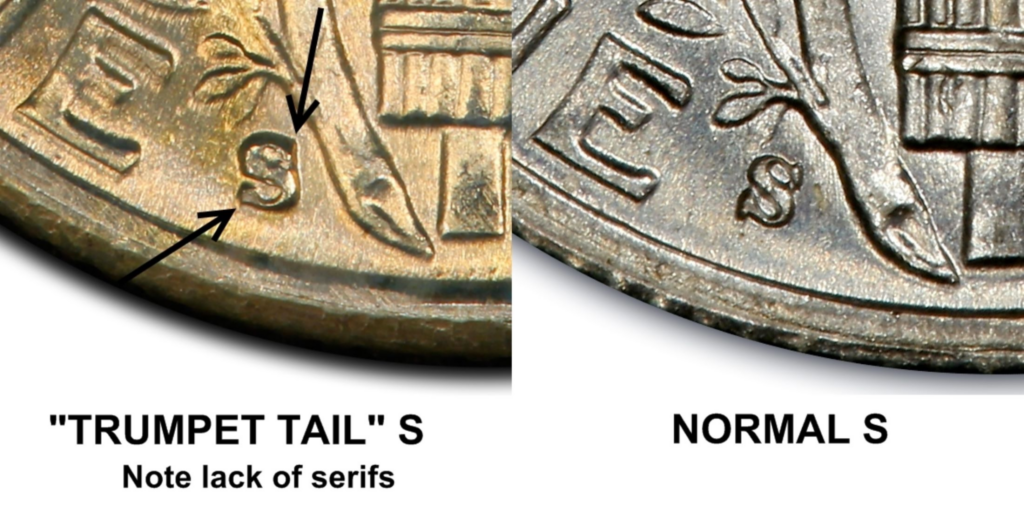
Repunched Mint mark (RPM)
As you can see in the image below, there is a small indent where the “S” mint mark was stamped into this die.
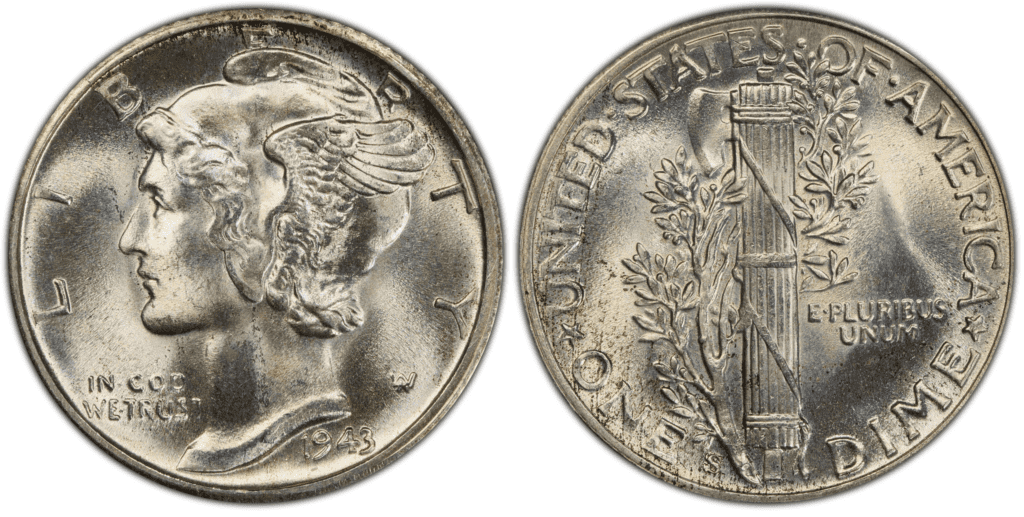
Doubled Die error (DDO)
This happens when the die moves while the coin is being hubbed, causing some features to double or shadow one another. As seen in the image below, a partial hubbing of this die left a duplicate impression of the motto IN GOD WE TRUST that was not eradicated by the subsequent, full impression.
Image Source: NGC
How Much Is The 1943 Mercury Dime Worth Today?
When estimating the nominal value of a 1943 Winged Liberty Head (Mercury) dime, several variables must be considered.
Of course, the coin’s condition is crucial. A coin’s value will be reduced if it is damaged. It also matters what kind of coin it is. Walking Liberty half dollars were struck in up to three varieties each year. As such, a coin’s type significantly impacts its value.
According to the USA Coin Book, the 1943 Winged Liberty Head (Mercury) dime’s estimated value is $2.78 in average condition and $6.37 to $28 or more in uncirculated (MS+) mint condition.
Its face value is set at $0.10. According to the NGC Price Guide, it is valued between $2.50 and $4 (as of January 2023). According to NGC, the 1942 Mercury dime’s melt value is set at $1.75.
Just to give you an idea of how much 1945 Mercury dimes were sold in the past, here’s a table of their auction records as listed by PCGS:
| Variety | Condition | Grade | Date Sold | Auction record |
| 1943 P Mercury Dime | Superb Gem Uncirculated – Full Band | MS68 | August 11, 2010 | $19,550 (Heritage Auctions) |
| 1943 S Mercury Dime | Superb Gem Uncirculated – Full Band | MS68 | May 8. 2022 | $16,800 (Heritage Auctions) |
| 1943 S Mercury Dime | Superb Gem Uncirculated – Full Band | MS68 | March 21, 2019 | $14,688 (Legend Rare Coin Auctions) |
How Does The Grading System Work?
The Sheldon Scale is used by numismatists to provide a numerical value to coins. The Sheldon Scale goes from poor (P-1) to perfect mint state (P-1) (MS-70). Coins were originally evaluated using words to reflect their condition (Good, Fair, Excellent, Etc.). Unfortunately, coin collectors and dealers had different ideas about what each of these terms represent.
Professional numismatists joined together in the 1970s and established CoinGrading standards. These numismatists now assign grades at key places on the seventy-point scale, using the most regularly utilized numeric points in conjunction with the original adjective grade. The following are the most common coin grades:
-
-
- (P-1) Poor – Indistinguishable and probably damaged; if used, must have a date and mintmark; otherwise, rather battered.
- (FR-2) Fair – Nearly smooth, but without the damage that a coin graded Poor often possesses. The coin must have enough detail to be identified.
- (G-4) Fair – Inscriptions have merged into the rims in some areas, and important elements have been mostly erased.
- (VG-8) Very Good- A little weathered, but all of the primary design elements are visible, albeit faintly. There is little if any, central detail left.
- (F-12) Good – The item is very worn, yet the wear is even, and the overall design details stand out clearly. Rims are almost completely isolated from the field.
- (VF-20) Very Fine – Moderately weathered, with some finer features still visible. The motto or all letters of LIBERTY are readable. Both sides of the coin have entire rims that are separated from the field.
- (EF-40) Extremely Fine – Gently used; all gadgets are visible, and the most important ones are bold. The finer details are bold and clear, however, light wear may be seen.
- (AU-50) Uncirculated – Slight evidence of wear on the coin’s design’s high points; may have contact marks; eye appeal should be adequate.
- (AU-58) Uncirculated Choice – Slight traces of wear, no severe contact marks, almost full mint shine, and great eye appeal.
- (MS-60) Mint State Basal – Strictly uncirculated; no indication of wear on the coin’s highest points, but an unsightly coin with reduced luster, visible contact marks, hairlines, and other flaws.
- (MS-63) Mint State Acceptable – Uncirculated, but with contact scratches and nicks, little reduced shine, but otherwise appealing appearance. The strike is weak to average.
- (MS-65) Mint State Choice – Uncirculated with great mint shine, very little contact blemishes, and exceptional eye appeal. The strike is unusually severe.
- (MS-68) Mint State Premium Quality – Uncirculated with superb luster, no obvious contact marks to the naked eye, and exceptional eye appeal. The strike is quick and appealing.
- (MS-69) Almost Perfect Mint State – Uncirculated with perfect brilliance, a sharp and appealing strike, and extremely good eye appeal. A near-perfect coin with minor imperfections in the planchet, strike, and contact markings (seen only under 8x magnification).
- (MS-70) Mint State Perfect – Under 8x magnification, there are no tiny imperfections discernible; the strike is crisp, and the coin is perfectly centered on a beautiful planchet. Rarely seen on a coin, this coin is bright and whole, with original luster and exceptional eye appeal.
-
Where To Buy Or Sell 1943 Mercury Dime?
Have you tried coin or antique shops when searching for a 1943 Winged Liberty Head (Mercury) dime? Because they might have some. But it is always more difficult to locate them there.
So, if you want an easier way, consider seeking one online. Online markets and auction sites such as eBay, Etsy, Craigslist, and Amazon are great examples of these online markets. You might come across merchants that sell rare coins if you’re lucky!
Also experts and professionals from PCGS and NGC can also help you if you need advice on where and how to buy or sell your 1943 Winged Liberty Head (Mercury) dimes.
FAQs
What makes a 1943 Mercury dime valuable?
Mercury dime coins from 1943 that are “uncirculated,” or without wear and still shiny, start to have collector value. Today’s collectors typically seek out “fresh new” dimes from this time. Collectors are drawn to these types of coins because of their bright luster and the fact that they were never circulated.
How rare is a 1943 Mercury dime?
The 1943 Philadelphia Mercury dimes are extremely common over most of the grading spectrum, from low-end circulated grades through at least MS66, with higher-grading coins, with the exception of MS68 specimens, being scarce but not particularly rare. But, if you have a silver coin hanging around your home, you could make money. A rare Mercury dime with an error went for almost $400 online.
Where is the mint mark on a 1943 Mercury dime?
If there is a mint mark, it can be seen around the torch’s left bottom rim. There is no mint mark for the Mercury dimes minted in Philadelphia.
What is the error on a 1943 Mercury Dime?
There are different types of errors that you can find on a 1943 Mercury dime. For example, Trumpet Tail “S,” where there is a lack of serifs in the “S” mint mark; Repunched Mint mark (RPM), where there is a small indent where the “S” mint mark was stamped into the die; or the Double Die error (DDO), which occurs when the die moves while the coin is being hubbed, causing some features to double or shadow one another.

